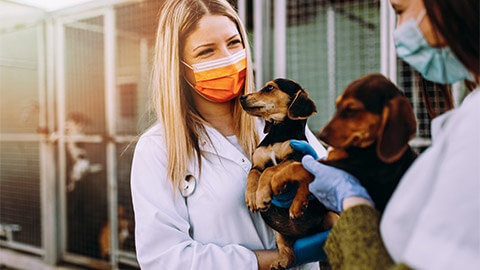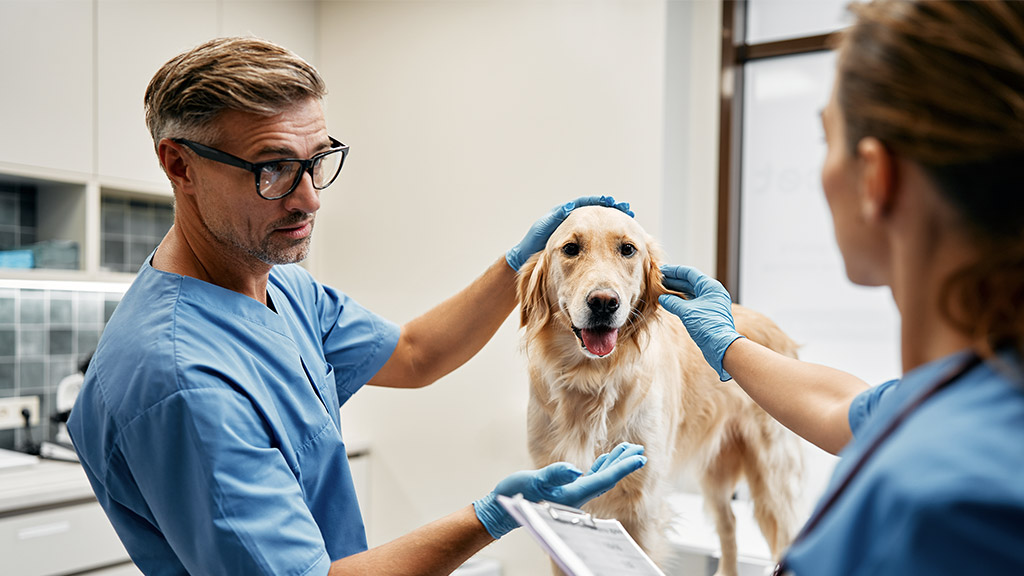Teamwork is a fundamental aspect of success within a business. Where animal care is concerned, working in a team and effectively communicating with one another is integral. Remember, you are dealing with the lives of animals, some of whom are the only companions individuals may have. Effective team communication is vital to the successful running of a business. When looking at animal care, without effective communication, there are risks to the health and care of the animal, without it resentment, incomplete tasks, bullying and many other negative aspects may occur.
Before we look into the basic principles of communicating with a team, the following video illustrates communication that has taken place between Dr Chris Brown and a police officer bringing in a puppy. As you watch the video, be mindful of the communication between the two and the listening techniques and responses that take place. You will also find a snippet of an emergency where the VET applied swift communication with his team in response to the treatment being applied to the animal.
When you are looking at effectively working in a team, there are basic communication principles that you can apply to ensure you and the rest of the team are effectively communicating.
Video
Before we delve into the basic communication principles, let's watch the next video to recap communication and its importance.
Next, let us look at the principles. Consider the following principles.
Respect one another
Everyone has a right to provide a suggestion or have an opinion, and they deserve to be heard. You don't necessarily need to agree with their idea, but you do need to respectively listen to them and, if need be, offer a constructive counterargument. Another element of respect is the attitude you display to your supervisors. They have earned their right to be respected, and you must be polite and follow their instructions.
Be polite and courteous
Simple manners can make all the difference when communicating with team members. Please, thank you, and excuse me. They are easily inserted into a conversation, request, or statement and should always be used.
Support one another
If a team member is extremely busy with a difficult situation, then you should offer to help them out. By supporting them in their time of need will hopefully be an act that is returned if you ever require assistance.
Tolerance
Workplaces can be very diverse. Differences in religion, race, age, gender, and sexual orientation can present some challenges with communication, however tolerance should always be practiced. Try to familiarise yourself with the different customs, hobbies and interests of your teammates. It goes without saying that abuse and discrimination should never occur, it is illegal and essentially cruel.
Empathy
Sometimes, people experience a hard time, either work-related or personal. Try to show understanding and consideration for their situation; however, don't offer direct advice unless you are specifically asked to.
Case Study
Happy Paws Animal Care Facility- Team Meeting
The team at Happy Paws Animal Care is dealing with a newly admitted dog, Rocky, who has shown signs of aggression. The team needs to discuss how to handle Rocky’s care while ensuring the safety of both staff and the animal.
Team Members Involved:
- Sarah (Animal Care Attendant)
- Tom (Veterinary Technician)
- Lisa (Animal Behavior Specialist)
- Emily (Kennel Manager)
| Team Meeting- Commences | |
 |
Emily (Kennel Manager): Speaking calmly and inviting everyone to share their thoughts “Thanks for gathering quickly, everyone. As you know, Rocky was brought in yesterday and had been showing aggressive behaviour towards staff. We need to discuss how to handle his care safely. Let’s start by hearing everyone’s thoughts and concerns. Sarah, you were the first to interact with him. Can you share your experience?” |
 |
Sarah (Animal Care Attendant): Speaking with empathy and understanding “Sure, Emily. When I approached Rocky’s kennel, he growled and lunged at the door. It was clear he was scared and stressed, so I tried to approach him slowly, but he didn’t calm down. I’m concerned that he might need more time and space before we can handle him safely.” |
 |
Tom (Veterinary Technician): Nodding and offering support “I agree, Sarah. It’s important to recognise that Rocky might be acting out of fear, not necessarily aggression. Maybe we can try giving him a quiet space with minimal interaction until he feels more comfortable. I’m happy to check on him regularly, but I’ll take it slow.” |
 |
Lisa (Animal Behavior Specialist): Speaking with tolerance, understanding, and respect “I appreciate how cautious you’re being, Tom. From a behavioural perspective, it’s crucial that we don’t rush Rocky into anything he’s not ready for. I can work on a gradual desensitization plan, where we slowly introduce him to staff and other animals, building trust over time. Does that sound good to everyone?” |
 |
Emily (Kennel Manager): With politeness and courtesy “That sounds like a solid plan, Lisa. I appreciate everyone’s willingness to work together on this. Sarah, how do you feel about managing Rocky’s care with this new approach?” |
 |
Sarah (Animal Care Attendant): Feeling supported and respected “I feel much better knowing we have a plan that considers Rocky’s needs and our safety. I’ll follow Lisa’s guidance and make sure to keep everyone updated on his progress.” |
 |
Tom (Veterinary Technician): Offering support, respect, and encouragement “If you ever need a hand, Sarah, don’t hesitate to ask. We’re all in this together, and I’m here to help.” |
 |
Lisa (Animal Behavior Specialist): Empathetically and with respect “And if you’re ever unsure about how to approach Rocky, just let me know. We can work through it together. His well-being and your safety are our top priorities.” |
 |
Emily (Kennel Manager): Concluding with courtesy, respect, and unity “Thank you, everyone, for your input and cooperation. Let’s implement this plan and keep the lines of communication open. If there are any changes in Rocky’s behaviour, we’ll adjust as needed. I appreciate your dedication to making sure Rocky gets the care he needs.” |
Key Communication Principles Demonstrated:
Tolerance:
- The team listens to each other’s experiences and perspectives without judgment, recognising that each person’s input is valuable.
Empathy:
- The team members show empathy towards both Rocky’s situation and each other’s concerns, ensuring that everyone feels understood and supported.
Support One Another:
- Team members offer to assist one another and are committed to working together to achieve the best outcome for Rocky.
Be Polite and Courteous:
- The conversation is conducted with respect and kindness, with everyone thanking each other and acknowledging the importance of each person’s role.
Respect One Another:
- Each team member’s expertise and opinions are respected, with everyone contributing to the plan and valuing each other’s contributions. There’s a mutual recognition of the importance of each role and the care taken in communication.

When engaging in any type of communication, it is important to consider how you can present yourself when you are speaking. This is not a matter of what you wear or how you look but the style in which you facilitate a presentation to stakeholders, whether they are internal colleagues or external clients.
There are several types of presentation styles. However, we are going to look closely at the following, which you may observe or need to apply in the animal care industry. Some of these may include:
- storyteller
- freeform
- visual
- director
- data scientist
- connector
- instructor
Let us look at these in further detail to help establish your understanding of each presentation style.
Storyteller
Those with a storyteller presentation style will often use an emotive approach from past experiences to gauge the audience’s attention. In animal care, you may observe a veterinarian providing examples of previous experiences during training or consultations with clients to help a message resonate. Those facilitating the storyteller style of presentations use this when they have ample time and do not need numbers, data or statistics to support their work.2
Freeform
The freeform presentation style is reserved for those with an abundance of experience on the topic that they are facilitating. In animal care, there are veterinarians who have specific fields of expertise, such as ophthalmology for animals. These vets would be able to use a freeform presentation style when they hold specific experience in their field. Like the storyteller, the freeform presentation style also applies the sharing of short stories or personal experiences to convey a message to the receiver.2
Visual
The visual presentation style, as the name suggests, relies heavily on the use of visual aids such as graphs, charts, and images to enhance the audience's experience. However, if you are choosing to use this presentation style, you will need to ensure you have a balance of both imagery and text to help support the presentation. One of the benefits of using this presentation style, especially with the complexity of animal studies, is that using visuals can help the audience understand what you are explaining. For instance, a vet may use an X-ray as a visual aid to help explain the issue to the nurse assisting with treatment.2
Director
The director's presentation style tends to add focus to a logical flow and will often have notes, scripts or palm cards prepared during their presentation. When using PowerPoint to carry out a slide show, they will arrange the slides in such a way that they align with the logical flow of their presentation style.2
Data scientist
Those who apply the data scientist presentation style emphasise the facts and data they have collated from statistics. This presentation style holds key advantages with persuasion if necessary. Contrary to this, where data is concerned, there is really no room for error, and you must ensure the information you are using or you have collected is legitimate and obtained from reliable sources. In the animal care industry, data can be particularly useful when it comes to advising on treatments for animals. For example, data may have been collected over time for the treatment of arthritis in dogs, if you know the specific statistics of the success rate of these treatments, the level of professionalism is elevated because there has been enough research conducted to support the recommendation.2
Connector
The connector presentation style is one to consider in the animal care industry because it relies on developing a connection with the audience. Humans are naturally compelled to interact and are more than likely to develop a sense of trust when they are connected to others. This is particularly important when establishing a relationship with clients and their pets. As you will come to learn, some people have only animal companions and often become rather distressed when their animals are unwell. Developing a connection between the client and the vet can help support a nurturing and trusting relationship.2
Instructor
Finally, we look at the instructor's presentation style. This particular presentation style is one you will find very early on in your career with those more experienced than you are, taking this approach to teach (or instruct) the high level of complexity in this industry. The instructor's presentation style will often use a logical order to support the ideas they are teaching or conveying to then break down into a simplified and easier-to-understand version of the same idea.2
Watch
The next video is a TED Talk about different communication styles.
The next video is an explanation on how to give great presentations.
Presentation Format
Presentation styles and presentation formats are related concepts, but they refer to different aspects of how information is delivered to an audience.
Different Aspects of How Information Is Delivered
- Presentation Format - refers to the structural method or medium through which the presentation is delivered. It's about the "how"– the overall setup and structure of the presentation.
- Presentation Style - refers to the manner or approach the presenter takes in delivering the content. It's about the "way"– the delivery and interaction with the audience.
Formats are about the setup and medium of the presentation, while styles are about the presenter's approach to delivering the content. Both are crucial for creating an effective presentation, and they often complement each other.
Presentation formats refer to the different methods and styles used to deliver information to an audience. The format you choose depends on the content, audience, and purpose of the presentation.
The structure refers to the organisation of the content within your chosen format. A well-structured presentation typically follows this sequence:
A. Introduction
Title Slide:
- Presentation title
- Your name and role
- Date and event (if applicable)
Agenda/Outline Slide:
- A brief overview of the main points you’ll cover. This helps set expectations and provides a roadmap for the audience.
Opening Statement:
- A hook to grab attention (a quote, question, statistic, or anecdote relevant to your topic).
- Introduction to the topic: Briefly explain the purpose and importance of the presentation.
B. Body
Main Points:
- Each main point or section should have its own slide or series of slides.
- Structure for Each Point:
- Introduction: Briefly introduce the point.
- Explanation: Provide details, facts, and explanations.
- Visual Support: Use images, charts, or diagrams to visually represent data or concepts.
- Examples/Case Studies: Provide real-life examples or case studies to illustrate the point.
Key Takeaways: Summarize the key message for each point before moving on.
Transitions:
- Use clear verbal and visual transitions between sections to maintain flow and guide the audience.
C. Conclusion
Summary Slide:
- Recap the main points briefly, reinforcing the key messages.
Closing Statement:
- Conclude with a strong closing statement. This could be a call to action, a thought-provoking quote, or a final summary of the benefits or importance of the information presented.
Q&A Slide:
- Invite questions from the audience. This is optional but useful for engaging with your audience and addressing any uncertainties.
Thank You/Contact Slide:
- End with a slide that thanks the audience and provides your contact information for follow-up.
Tip
Design and Delivery Tips
- Consistency: Keep a consistent design theme across all slides (fonts, colours, layout).
- Visual Hierarchy: Use headings, bullet points, and visuals to create a clear visual hierarchy, making it easier for the audience to follow along.
- Engagement: Plan for moments of audience interaction (polls, questions, or short discussions) to keep them engaged.
- Practice: Rehearse your presentation to ensure smooth delivery, timing, and familiarity with the content.

Your job role in the animal care industry will have many rules, regulations, and instructions that you are required to abide by. It is your responsibility to ensure you are aware of them and endeavour to follow them all.
Instructions may include formal policies and procedures and workplace guidelines such as dress codes and hours of work. They are likely written in a Code of Conduct or a Policies and Procedures Manual, and you will be informed of them as part of your workplace induction. Ramifications for not abiding by these types of instructions may be that the business is breaking the law, or a serious accident may occur, or there is a loss of money. Ensure you are aware of all the relevant policies and procedures that relate to your job role and undertake them to the best of your ability.
Other instructions may be less formal; they might be directions issued by your supervisor, or they may be requests made by other colleagues. As these types of instructions are not usually written down (unless they have been emailed to you), it is important that you listen properly and seek clarification if you are confused about the request. Always follow through on informal tasks and report back to the person who issued the request with a progress report when you have finished.
Within the animal care industry, seeking clarification is particularly important as you are dealing with the lives of animals. In high-risk situations, you may be quite stressed and exhausted from keeping up with a high pace, so it is normal for someone to become flustered or miss things if their mind is not clear or present now. Sometimes, you may not even recall every single step for a range of reasons. If you find that this is a common occurrence, it may also be that you need a different method to keep up with the high load of new information. The following are some examples of how you can keep up with higher loads of information.
- Refer to the poster.
- Take notes.
- Watch videos.
- Engage in further training.
Find out what works well for you and then discuss it with your supervisor to apply it to your role. It is always better to be proactive rather than reactive.
Case Study
Instruction Guide: Cleaning Animal Cages at Happy Paws Animal Care
Below is an example of of instructions from Happy Paws Animal Care in regards to cleaning cages.
|
1. Preparation:
|
|
2. Remove Soiled Items:
|
|
3. Clean the Cage:
|
|
4. Rinse and Dry:
|
|
5. Reassemble the Cage:
|
|
6. Final Check:
|
|
7. Post-Cleaning:
|

Team meetings are common and often a compulsory requirement in many companies or businesses. Workplace meetings usually follow some sort of set pattern. This may relate to when they are scheduled. Some may be weekly, how long they run for, perhaps 1 hour, where they are held in the board room or a more informal location.
They often have an agenda, which is effectively a list of the proposed discussion points. Usually, in the lead-up to the meeting, the agenda will be circulated, and input will be requested. Depending on your workplace, the team meetings may be very formal, or they might be quite relaxed chats; this will probably depend on the type of management structure that exists and the topics covered in that meeting.
Formal meetings tend to be held in meeting/board rooms and have a chairperson. Formal notes, known as minutes, will be kept outlining the main discussion topics and follow-up tasks. Minutes can be beneficial to anyone who did not attend the meeting.
Informal meetings may be smaller group chats held either in the office or outside, perhaps at the local coffee shop. Formal minutes may not be recorded; however, participants may be encouraged to take their own notes.
An example of an informal meeting could be a catch-up on the clinic's happenings via the social media platform, and an informal meeting could be about staff first aid training, which is to be scheduled in the coming days.
Regardless of the type of meeting, there are some basic guidelines that you should always follow.
- Read the agenda before the meeting, and familiarise yourself with the proposed topics. Perhaps contribute your own item/s.
- If you are required to provide a report or summary of your duties, then be prepared with any handouts, presentations, or statistics. Prepare some basic dot points of what you need to say so that you do not forget anything.
- Be an active participant in all the discussion topics, ask questions and provide suggestions.
- Be an effective listener for the duration of the meeting, and understand that not all the ideas raised will be exactly what you have in mind.
- Remain open to new ideas and suggestions and give praise where possible. It is not easy to bring a new idea to the table, so it is important to acknowledge and show appreciation to ensure the other team members feel comfortable sharing their thoughts.
- Take notes - while it is not necessary to jot down notes, it is an effective way to retain information for yourself or others to access or review. This way, you can access this later to simply obtain a refresher of what was discussed. E.g. In the meeting, the practice manager explained that all pets coming in as standard patients are to enter from the front of the building. However, all other patients are to be entering from the back entrance to avoid using the staircase. This kind of information would be a small detail for the meeting, but it is important to remember for now and in the future.
Watch
The next couple of videos demonstrate some strategies on how to host and make effective team meetings.
Case Study
Below is an example of a Team Meeting Agenda from Happy Paws Animal Care Facility.
Happy Paws Animal Care- Team Meeting Agenda
- Date: August 20, 2024
- Time: 10:00 AM – 11:30 AM
- Location: Happy Paws Animal Care – Conference Room
1. Welcome and Introduction (10:00 AM – 10:05 AM)
- Facilitator: Emily, Kennel Manager
- Brief welcome and overview of the meeting agenda.
- Acknowledgment of any new team members or announcements.
2. Review of Previous Meeting Minutes (10:05 AM – 10:15 AM)
- Facilitator: Emily, Kennel Manager
- Recap of key points from the last meeting.
- Discussion of any follow-up actions or unresolved items.
3. Animal Care Updates (10:15 AM – 10:30 AM)
- Facilitators: Sarah, Animal Care Attendant & Tom, Veterinary Technician
- Updates on current animal cases, including any new admissions, health concerns, or behavioural observations.
- Discussion of Rocky’s progress and any adjustments to his care plan.
- Q&A session for any specific animal care concerns.
4. Facility Maintenance and Safety (10:30 AM – 10:45 AM)
- Facilitator: Lisa, Facility Supervisor
- Review of recent maintenance issues and upcoming repairs or improvements.
- Discussion of safety protocols, including emergency procedures and the proper use of cleaning supplies.
- Open the floor for any safety concerns or suggestions.
5. Training and Development (10:45 AM – 11:00 AM)
- Facilitator: Lisa, Animal Behavior Specialist
- Introduction of upcoming training sessions and workshops for staff.
- Overview of new training materials or resources available to the team.
- Discussion on areas for skill development and how to address them.
6. Team Communication and Collaboration (11:00 AM – 11:15 AM)
- Facilitator: Emily, Kennel Manager
- Discussion on improving internal communication, including the use of communication tools and protocols.
- Emphasis on the principles of tolerance, empathy, support, politeness, and respect in team interactions.
- Strategies for enhancing collaboration across different roles within the facility.
7. Open Forum and Q&A (11:15 AM – 11:25 AM)
- Facilitator: Emily, Kennel Manager
- Open floor for team members to raise any issues, concerns, or suggestions.
- Opportunity for staff to ask questions and provide feedback on any topics discussed.
8. Closing Remarks and Next Steps (11:25 AM – 11:30 AM)
- Facilitator: Emily, Kennel Manager
- Summary of key takeaways from the meeting.
- Assignment of action items and deadlines.
- Schedule and agenda preview for the next team meeting.
